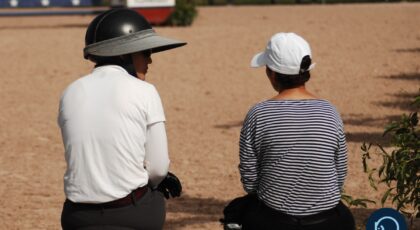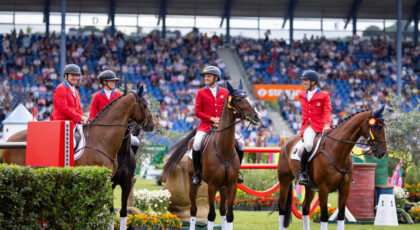Most of us recognize that horses communicate with each other via body language, but did you know that you can learn his “words” and “phrases” and use them with horses with exciting results? Sharon Wilsie, of Wilsie Way Horsemanship, and horsewoman Gretchen Vogel have written a book called Horse Speak: The Equine-Human Translation Guide, which says that insisting the horse understand and react to our language without attempting to understand and react to his leads to a lot of miscommunication between horses and humans. But it doesn’t have to be this way anymore. Here’s the first step to having meaningful, positive, progressive conversations with your horse.
∗∗∗
Many of us may try to be calm around horses as a general rule, but for the process of learning Horse Speak, it is essential. Being “quiet inside” allowed me to be more “present” (in the moment), which is how I was able to observe the subtleties of equine language to begin with. Establishing ways to be “present” with your horse is how you will see their language, as well. I call the state of being present in the moment, being aware and calm, Inner Zero.
Zero is the first thing I teach any of my students. I ask them to imagine a favorite peaceful spot—a happy place. Some think of a favorite song, a lovely image, or an emotionally fulfilling memory. We all have individual gateways to our Zero. Practice the feeling that comes over you when you think of the trigger image, sound, or memory and return to it repeatedly. This is Zero on the inside.

Inner Zero is the art of finding inner calm. ©Rich Neally
The best way to clearly communicate with horses is with planned, deliberate gestures. When your inner intensity level is calm or Zero, it does not mean being too quiet or tentative. Horses prefer us to move with purpose, be aware of the environment, and be confident leaders. Quiet, confident assertiveness equates to “calm” for horses. It tells them, “All is well.” In addition, being calm promotes mutual trust because horses aspire to stay in this state.
Most of the time horses whisper with their body language. A peaceful head nod, tiny twitch of the tail, the intention to pick up a foot with a shift of balance—these say all they need to another horse. Occasionally, a horse shouts or yells a message at another with extreme gestures or movement, but usually horses say what they need to at the lowest volume necessary. Even if they “turn up” the volume, they are experts at then turning it back down, calibrating the movements of their language precisely.
Horses are good at this, but we have to practice. For the sake of mutual conversation, it is vital you understand how to adjust the volume of your own movement in response to theirs. You can learn to mimic their language and adjust your volume with the appropriate intensity. To make this easier, I have assigned numbers to represent the levels of intensity of physical movement or volume you might use in a conversation with a horse. I use five numbers: Zero, One, Two, Three, and Four. As the numbers increase, so does the size and/or emphasis of your movement.

Movement that has purpose communicates clear intention. ©Rich Neally
In general, Zero on the outside is like Zero on the inside: it means complete calm in mind and body. What does Outer Zero look like? Zero intensity, energy, or attitude doesn’t mean you are not doing anything; Outer Zero is the way you are doing it, physically, and has different postures. You could:
• Bend one knee to cock your own hip sideways—the way horses do.
• Put your hands in your pockets, soften your gaze, and drop your head slightly while breathing deeply.
• Look at the ground and “blow out” a sigh.
• Make your body look limp like a rag doll.
We all develop our own versions of Outer Zero around our horses.

Learning when to pause, return to Zero, and give the horse time to think is crucial to the art of conversation. ©Rich Neally
The next phase of intensity is Level One, which is intention (your determination to act a certain way) alone without much movement at all. Level Two volume adds motion to intention. Level Three adds movement toward the horse and may include touch. Level Four volume is most intense including the largest of gestures in any given situation. Another way to look at this is to consider the five phases of physical movement or volume as: Calm, Thinking, Asking, Telling, and Insisting.
Remember this is not about training—just about language. Different intensities of movement are the adjectives in Horse Speak. Your goal is to habitually return to Outer Zero no matter what level of intensity has been used for any exercise or Conversation. But ceasing intention, motion, gesture, or touch (“turning down” the volume) is the hardest thing for any of us to learn. If you practiced nothing but returning to Inner and Outer Zero whenever and wherever it might be necessary, many of your problems with your horse would melt away. Horses let go of stress and effort more easily than humans do. We tend to relive an emotional charge long after the incident is over.
Zero can help change this.
∗∗∗

This excerpt from Horse Speak: The Equine Human Translation Guide by Sharon Wilsie and Gretchen Vogel is reprinted with permission from Trafalgar Square Books.

 December 7, 2016
December 7, 2016 

























